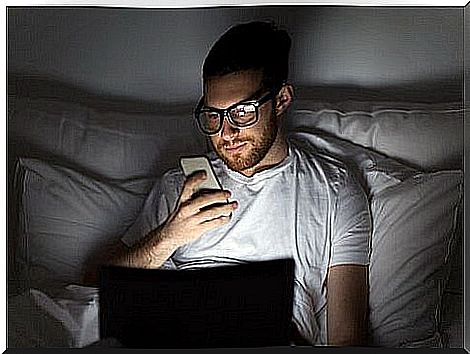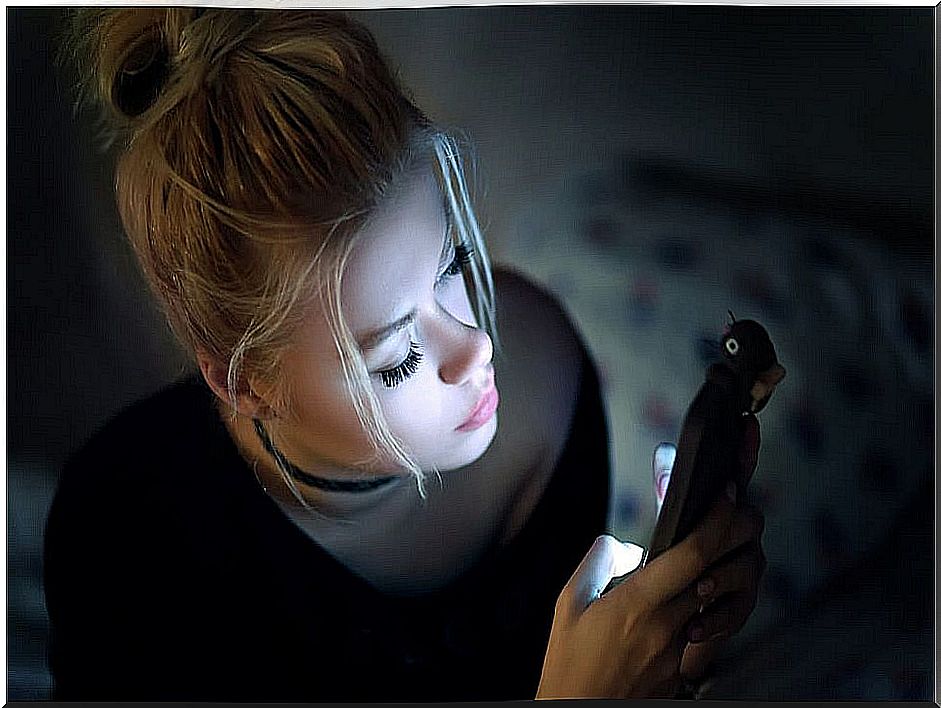Technological Insomnia: What Is It About?
Technological insomnia is known as the sleep disorder that occurs linked to the use of technology, especially mobile phones, with screens. We can include here smartphones , tablets and notebooks, mainly, televisions being in second place.
This single definition already puts most of us on guard. It is very rare that we escape the habit of conducting a final check on the mobile phone before going to sleep. The problem is that this check-up tends to be overdone, going from about five minutes to an hour or more.
The Internet and social networks always offer something else to keep us connected. A message brings a link, a page suggests a video or we catch up with what we had to answer and that we could not because of the daily bustle.
When we want to stop, too much time has passed, and our total hours of effective sleep are reduced. If the cycle does not stop and repeats itself constantly, the body begins to fail in its functions.
The problem of sleep disorders, in general, is quite frequent. It is estimated that a quarter of the population suffers from some sleep disturbance, and up to half may report some kind of problem falling asleep immediately when in bed. As for technological insomnia, possibly a third of those under 18 years of age are affected.
The point is that a bad rest reverberates the next day during wakefulness. We are less productive, less effective, slower in our reflexes and, therefore, more dangerous when performing actions such as driving.
Common insomnia or technological insomnia
Insomnia has existed as a sleep disorder for many centuries. And despite its old age, it remains a prevalent problem. Up to 10% of the adult population suffers from chronic insomnia, that is, they experience problems falling asleep on a daily basis. Among children, up to a third of them have unhealthy sleeping habits.
In common insomnia there are different factors and causes. The most common is that the problem is linked to an anxiety disorder, stress or poor sleep hygiene. Technological insomnia, on the other hand, has a specific cause: screen technology.
Its appearance is more or less recent because the massive introduction of technology is also recent, especially with the massification of smartphones . Being able to carry mobile phones everywhere, even to the bed itself, we cannot get rid of these devices.

Within technological insomnia we can distinguish two forms of technology capable of generating it. However, each of them does not produce the same amount of effect:
1. Passive
Passive display technology is, for example, the television. It is so named because it does not require regular interaction from the viewer. It is possible to turn on the television, put a channel and leave it fixed to watch it for hours. The screen stimulates the brain, but at a greater distance than a tablet, for example.
2. Active
It is the technology that seeks interaction through the screen. Online video games are the quintessential example. The stimulus they provoke on the retina and the brain is extreme, activating many areas and spreading blue light to the eyes without interruption. Social networks have a similar effect, especially of brain stimulation due to the interaction they represent.
The blue light problem
Tech screens emit radiation known as blue light. It has been scientifically proven that this luminescence is capable of altering the secretion of hormones in the body, such as the release of melatonin.
Melatonin is a key substance for the circadian sleep-wake cycle. When light is scarce in the environment, our body releases the hormone so that we are sleepy and go to bed to rest. It is a defense mechanism to maintain vital functions in their optimal state.
Screens, by inhibiting melatonin, interfere with the sleep-wake cycle. At bedtime, instead of what would be natural, the screens inform us that we must stay awake. The light from the tablet or smartphone hits the retina, a neurological signal is sent to the suprachiasmatic nucleus of the brain, and melatonin synthesis stops.
Before the repetition of the stimulus, the circadian cycle begins to delay. Our body thinks it interprets that the light is constant and that you have to be awake as many hours as possible. But it’s not like that. The organs continue to require rest for their proper functioning.

Recommendations to avoid technological insomnia
It is important that we take some simple steps to reduce the problem of technological insomnia. Whether we already suffer from it, or if we notice the first symptoms, the application of these tips will be useful to stop the process:
- Low brightness: we should lower the brightness of the screens at dusk and dusk, to attenuate its effect on melatonin.
- Avoid electronics before bed: it would be ideal to create a routine where technological devices are out of reach the hour before going to bed.
- Remove screen devices from the room: in line with the previous advice, it would also be ideal if there are no screens around our bed that we can use. Their mere presence will generate the anxiety of putting our eyes in front of them.
- Activate night modes: several applications have implemented dark modes or night modes so that the brightness of the screens is lighter and the background becomes black. The intention of these modes is to reduce the effect that we have been commenting on.
- Do not compensate with medication: if we suffer from insomnia, regardless of the case, a bad decision is to start taking drugs to sleep without medical consultation. We could be adding one more problem, instead of fixing it.
Ultimately, we must be more aware of this situation and take steps to avoid it. Although it may seem harmless at first, technological insomnia can lead to other physical and mental health problems.









